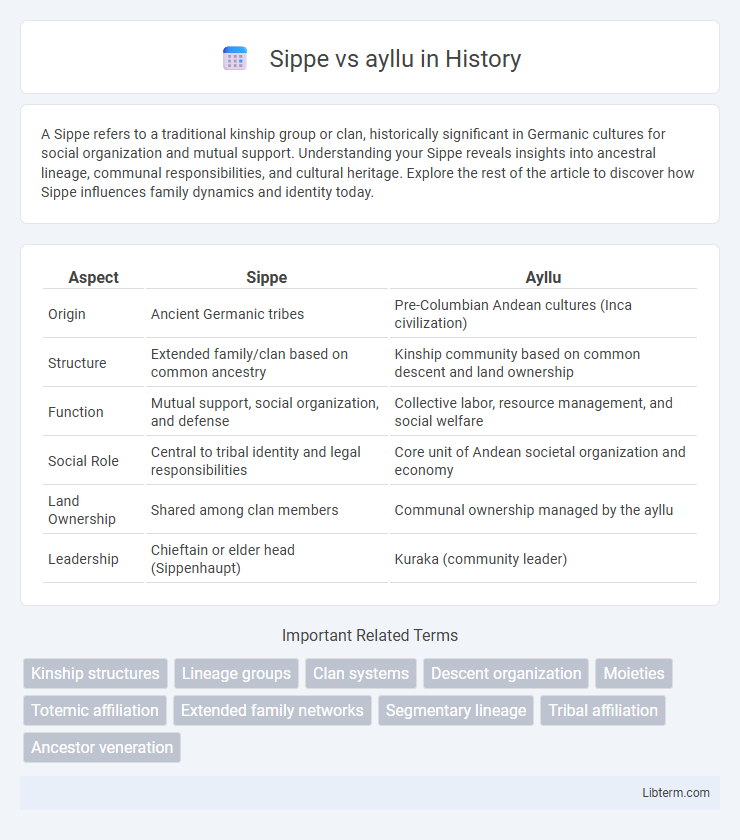A Sippe refers to a traditional kinship group or clan, historically significant in Germanic cultures for social organization and mutual support. Understanding your Sippe reveals insights into ancestral lineage, communal responsibilities, and cultural heritage. Explore the rest of the article to discover how Sippe influences family dynamics and identity today.
Table of Comparison
| Aspect | Sippe | Ayllu |
|---|---|---|
| Origin | Ancient Germanic tribes | Pre-Columbian Andean cultures (Inca civilization) |
| Structure | Extended family/clan based on common ancestry | Kinship community based on common descent and land ownership |
| Function | Mutual support, social organization, and defense | Collective labor, resource management, and social welfare |
| Social Role | Central to tribal identity and legal responsibilities | Core unit of Andean societal organization and economy |
| Land Ownership | Shared among clan members | Communal ownership managed by the ayllu |
| Leadership | Chieftain or elder head (Sippenhaupt) | Kuraka (community leader) |
Understanding the Sippe: Definition and Origins
The Sippe is a traditional kinship group originating in Germanic societies, defined by blood relations and shared ancestry within extended family units. It functioned as a fundamental social structure for collective responsibility, mutual support, and inheritance rights. Unlike the Ayllu of Andean cultures, which integrates community land management and collective agricultural practices, the Sippe emphasizes lineage continuity and legal obligations among its members.
What is an Ayllu? Cultural and Historical Background
An ayllu is a traditional form of community in the Andes, primarily among Quechua and Aymara peoples, characterized by a kinship-based social structure centered on collective land ownership and shared labor. Rooted in pre-Inca civilizations, the ayllu served as both an economic unit and a social organization that maintained cultural practices, rituals, and reciprocal obligations among its members. Its communal principles contrast with the Germanic concept of a sippe, which emphasizes a broader clan system based on bloodlines without necessarily integrating shared territorial or agricultural responsibilities.
Sippe vs Ayllu: Key Structural Differences
Sippe and Ayllu represent distinct kinship systems with Sippe rooted in Germanic tribal structures emphasizing extended family ties bound by blood and mutual responsibilities. In contrast, Ayllu, prevalent among Andean indigenous communities, functions as a socio-economic unit combining lineage with communal land ownership and collective labor. Key structural differences include Sippe's focus on consanguineous descent groups versus Ayllu's integration of kinship with territorial and resource management.
Social Organization in Sippe and Ayllu
The Sippe structured social organization around extended kinship groups tracing lineage and shared ancestry, emphasizing blood relations for collective responsibilities such as property management and mutual aid. In contrast, the Ayllu integrated kinship with territorial community, combining familial ties with communal land ownership and cooperative labor systems to maintain social cohesion and resource distribution. Both systems reinforced social identity through collective obligations but differed in their spatial focus and economic integration within their respective cultures.
Leadership and Governance in Sippe and Ayllu
Sippe and Ayllu are indigenous social units with distinct leadership and governance structures; Sippe, rooted in Germanic tribes, features kin-based leadership often led by elders or chieftains emphasizing familial hierarchy and mutual obligation. In contrast, Ayllu, prevalent among Andean communities, operates under a collective governance system where leaders such as the Mallku manage communal resources and mediate social responsibilities based on reciprocal relationships and ancestral lineage. Both systems prioritize community cohesion, but Sippe governance centers on bloodline authority while Ayllu emphasizes collective decision-making within extended family groups.
Kinship and Family Roles in Sippe and Ayllu
Sippe and Ayllu represent distinct kinship systems where Sippe, rooted in Germanic tradition, emphasizes lineage-based clan structures with strong male-centric roles defining family authority and inheritance. Ayllu, prevalent in Andean indigenous cultures, operates on extended family networks integrating communal land ownership and reciprocal labor obligations, highlighting collective responsibility beyond nuclear family ties. Both systems prioritize kinship bonds, but Sippe centralizes patriarchal lineage while Ayllu embraces egalitarian kin roles linked to social and economic cooperation.
Economic Functions: Sippe Compared to Ayllu
The Sippe functioned as a kinship-based economic unit in Germanic societies, emphasizing shared land, mutual labor, and collective resource management to sustain family livelihoods. In contrast, the Ayllu of Andean cultures operated as an extended community with a more complex reciprocal economy, integrating communal ownership, rotational labor systems like mita, and redistribution to support social cohesion and agricultural productivity. While both systems prioritized collective responsibility, the Ayllu's economic model was more structured in state-influenced redistribution, whereas the Sippe relied heavily on familial ties and local autonomy in economic decisions.
Spiritual and Religious Significance
Sippe and ayllu are indigenous kinship structures with profound spiritual and religious significance in their respective cultures. The Sippe, rooted in Germanic traditions, centers on ancestral worship and the preservation of familial spirits, often involving rituals to honor past generations. In contrast, the Andean ayllu integrates communal land ownership with a cosmology that venerates Pachamama (Mother Earth) and ancestral deities, embodying a holistic spirituality that intertwines social cohesion with sacred environmental stewardship.
Sippe and Ayllu in Modern Times
The Sippe and Ayllu represent distinct kinship-based communities with the Sippe rooted in Germanic tribal traditions emphasizing extended family bonds and mutual obligations, while the Ayllu, originating from Andean indigenous cultures, centers on communal land ownership and collective labor. In modern times, the Sippe's influence has largely declined, with remnants seen in cultural heritage and regional identities in parts of Germany and Central Europe. Conversely, the Ayllu persists robustly in countries like Peru and Bolivia, actively shaping indigenous social organization and land rights within contemporary political frameworks.
Comparative Impact on Community Identity
Sippe and ayllu both serve as foundational kinship groups shaping community identity but differ in cultural context and social structure. The Sippe, a Germanic clan system, emphasizes lineage continuity and hierarchical ties influencing legal and social duties within early Germanic tribes. In contrast, the Andean ayllu integrates kinship with economic cooperation and shared land management, profoundly reinforcing collective identity and resource sustainability in indigenous societies.
Sippe Infographic

 libterm.com
libterm.com